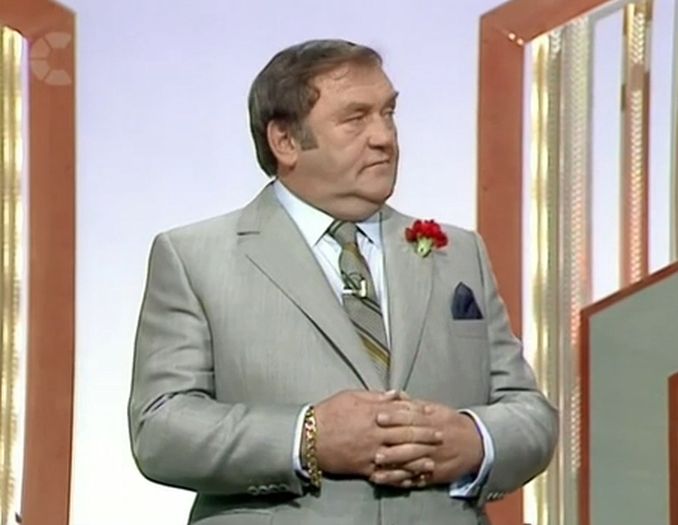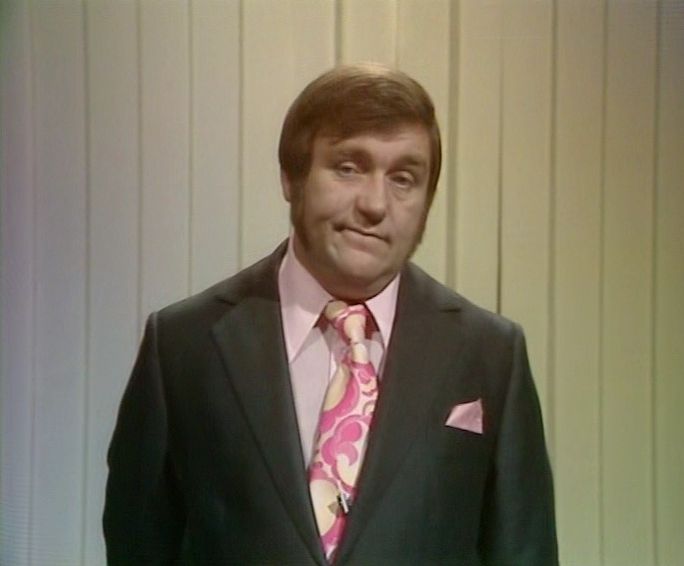
Les Dawson’s road to television stardom was a long and rocky one. Born in Collyhurst, Manchester in 1934, Dawson pursued numerous dead-end jobs whilst attempting to break into the comedy world. After many false starts, thanks to a spot on Opportunity Knocks his luck slowly began to change.
His own show – Sez Lez – which ran on Yorkshire Televison from 1969 to 1976 was key in establishing his brand of entertaining miserablism. Whilst some of the early editions were a bit thin comedy-wise, the arrival of a crop of experienced writers such as Barry Cryer and David Nobbs gave the show a considerable boost. Having John Cleese as a regular co-star for a while didn’t hurt either.
Whilst with Yorkshire, Dawson also appeared in The Loner (scripted by Alan Plater) and Dawson’s Weekly (penned by Galton and Simpson) so he didn’t lack for heavyweight writers. Throw in a number of one-off specials, guest spots on other people’s programmes and appearances on panel shows such as Joker’s Wild and Celebrity Squares and it’s fair to say that by the mid seventies Dawson had well and truly arrived.
His defection to the BBC in 1977 wasn’t a shock on the same level as the departure of Morecambe and Wise to Thames, but it still raised a few eyebrows. Lacking his familiar group of writers (even though they would have been happy to continue working with him) Dawson’s first BBC starring venture – imaginatively titled The Les Dawson Show – turned out to be something of a damp squib.
The writers – including Eddie Braben and a young David Renwick – were strong, but in some respects it seemed to be little more than a Sez Lez rehash (Les interacting with guest stars – such as Lulu – plus regular spots for singers and dancers). The time was clearly right for Les to do something a little different next time and so The Dawson Watch (1979 – 1980) was born.
Dawson’s monologues (which he wrote himself, the sketches tended to be penned by other writers) often railed at life’s follies, so a series in which Les examined a different hot topic each week (Housing, Transport, Money, etc) was something which played to his strengths.
Along with a new writing team – Ian Davidson as script editor, Terry Ravenscroft and Andy Hamilton providing the sketches – the show began to take shape. The Dawson Watch has the air of a consumer programme in which Les introduces sketches illustrating the topic of the week whilst moving around a studio packed with high-tech equipment (well, high-tech for the late seventies) and attractive young ladies pushing buttons.

It’s fair to say that the first series was a learning experience for all concerned. Dawson seemed a little ill-at-ease in the first programme, only coming to life when he began to banter with the audience about where they live. Once he does that – and presumably starts to go off-script – he visibly perks up. Although there’s plenty of new material in his monologues, several old favourites (“until I was fifteen, I thought that knives and forks were jewellery”) also receive airings.
There are so many gems which can be mined from Dawson’s routines, such as this bleak portrait of Christmas. Les confided that he could “only remember being given one Christmas present by my father. It was a do-it-yourself electric train set. Turned out to be a roll of fuse wire and a platform ticket”.
Possibly the major failing of the first series is the fact that Dawson doesn’t appear in many of the sketches. Familiar faces such as Cosmo Smallpiece and Cissie and Ada do pop up, but most of the sketches are handled by others. There’s certainly some very talented performers on view during these early shows – Sam Kelly, Johnny Ball, Michael Knowles, John Junkin, Patrick Newell, Terence Alexander, David Lodge, Andrew Sachs – but it would have been much more enjoyable had we seen Dawson playing off against them.
However, one of Les’ early sketch appearances (with Roy Barraclough as Cissie) is a Dawson classic.
CISSIE: Leonard and I went to Greece last year.
ADA: Oh, Bert and I have been to Greece, with Wallace Arnold’s Sunkissed Package Holiday and Inter-Continental Tours.
CISSIE: Oh, really? Did you have the shish kebabs?
ADA: From the moment we arrived. All down that side.
CISSIE: Did you see the Acropolis?
ADA: See it? We were never off it.
Clearly lessons had been learned for series two as Dawson takes a much more central role in the sketches whilst Vicki Michelle (as one of the computer girls) proved to be a welcome additon to the line-up. The girls in the first series were rarely called upon to be anything more than mute and attractive – acting simply as fodder for Dawson’s remarks – but Michelle possessed the comic chops to be able to engage in banter with him (which made Les’ lecherous advances seem a little less uncomfortable).
The astonishing roster of familiar faces making guest appearances during series one was reduced for the second and third series. As was more common with series of this type, a “rep” of performers was used instead – Roy Barraclough headed the list, with Daphne Oxenford and Gordon Peters amongst the other regulars.
The formula remained the same for the third and final series (broadcast in 1980 and culminating with a Christmas Special discussing the obvious topic of Christmas). Vicki Michelle wasn’t featured so prominently, although one of her future Allo, Allo! co-stars, Kirsten Cooke, made a few appearances whilst it was also nice to see the likes of George Sweeney and Michael Keating.
Compared to some of his contemporaries, such as Mike Yarwood and Dick Emery, Les Dawson is very well represented on DVD. Virtually all of his surviving ITV material can be purchased from Network whilst this release from Simply constitutes a welcome chunk of his later BBC work. Hopefully more will surface in the future.
Whilst some aspects of Dawson’s humour haven’t aged well, there’s still so much of interest here – his wonderfully crafted monologues, the impressive parade of supporting actors – to make it easy for me to wholeheartedly recommend this release.
The Dawson Watch consists of nineteen 30 minute episodes spread across three discs (six, six, seven) and is subtitled. It’s released tomorrow (4th March 2019) by Simply Media and can be ordered directly here (quoting ARCHIVE10 will apply a 10% discount).




















































